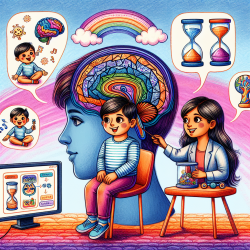Empowering Connections: Harnessing Virtual Interactions for Better Child Outcomes
The COVID-19 pandemic has significantly altered how we interact, forcing a rapid transition to virtual environments. A recent study titled Sociability, Social Isolation, and Social Interaction During the First Months of COVID-19 Pandemic: a Qualitative Analysis of Brazilian, Finnish, and American Adults provides valuable insights into how adults adapted to these changes. These findings can be instrumental for practitioners in speech-language pathology, especially those working with children through online therapy platforms like TinyEYE.
Key Findings and Their Implications
The study revealed several critical outcomes:
- Family Bonds Strengthened: Social isolation did not significantly alter social networks, but family connections became more central. This suggests that maintaining strong family ties can be a protective factor against the negative impacts of social isolation.
- Virtual Interactions Are Essential: Despite reduced frequency, the significance of social interactions increased. Virtual environments provided a crucial platform for maintaining social networks, emphasizing the importance of digital tools in sustaining relationships.
- Cultural Influences: Cultural values influenced how participants experienced and adapted to virtual interactions. Understanding these cultural nuances can help tailor interventions to be more effective and culturally sensitive.
Practical Applications for Practitioners
Here are some actionable steps practitioners can take based on the study's findings:
1. Strengthen Family Involvement
Encourage parents and family members to be actively involved in the child's therapy sessions. This can help reinforce the child's learning and provide emotional support, making the therapy more effective.
2. Leverage the Power of Virtual Tools
Utilize various digital tools to create engaging and interactive therapy sessions. Tools like video calls, interactive games, and virtual whiteboards can make sessions more dynamic and maintain the child's interest.
3. Cultural Sensitivity
Be mindful of the cultural backgrounds of the children and their families. Tailor your approach to respect and incorporate cultural values, which can enhance the effectiveness of your interventions.
4. Focus on Quality of Interaction
While the frequency of interactions may have decreased, their significance has increased. Focus on making each session meaningful and impactful. Quality over quantity should be the guiding principle.
5. Address Technological Barriers
Ensure that both you and the families you work with have access to reliable technology. Provide guidance on using digital tools effectively to minimize disruptions and enhance the therapy experience.
Encouraging Further Research
The study highlights the need for ongoing research into how virtual environments impact sociability and therapy outcomes. Practitioners should stay informed about the latest research and be open to adapting their methods based on new findings. Collaboration with researchers can also provide valuable insights and contribute to the development of more effective therapy techniques.
To read the original research paper, please follow this link: Sociability, Social Isolation, and Social Interaction During the First Months of COVID-19 Pandemic: a Qualitative Analysis of Brazilian, Finnish, and American Adults.
Conclusion
The COVID-19 pandemic has reshaped how we interact, but it has also provided opportunities to innovate and adapt. By leveraging the insights from recent research, practitioners can enhance their virtual therapy sessions and create better outcomes for children. Embracing technology, strengthening family involvement, and being culturally sensitive are key strategies that can make a significant difference.










